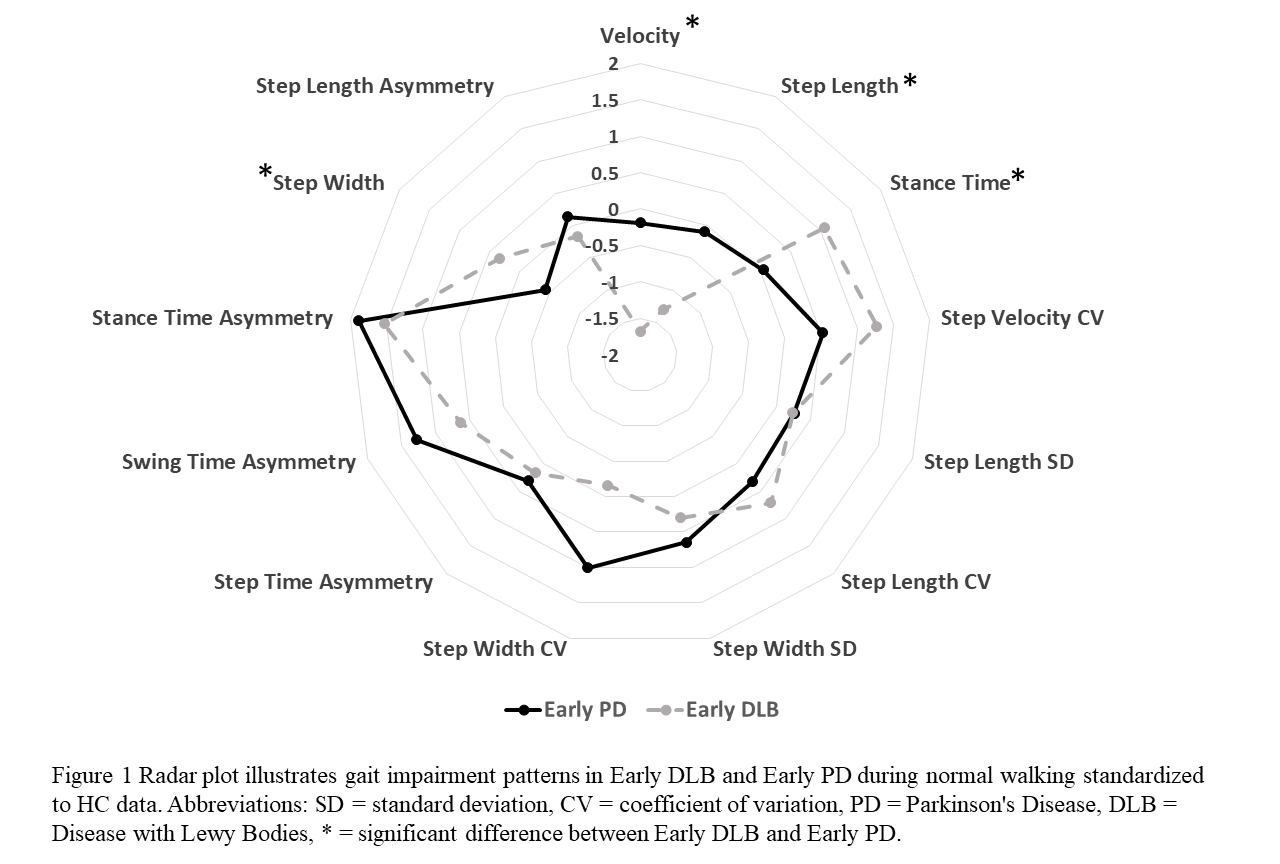Objective: To characterize and differentiate gait deficits early on in individuals with DLB and PD.
Background: Dementia with Lewy bodies (DLB) and Parkinson’s disease (PD) can be difficult to differentially diagnose. Evidence suggests that quantitative gait may be a sensitive and specific marker for discerning dementia subtypes [1]. Patients with PD dementia (PDD) exhibit greater gait asymmetry than those with DLB during normal walking, and both PDD and DLB have greater step velocity variability than Alzheimer’s patients [1]. While gait can differentiate advanced dementia subtypes, it remains less clear whether differences exist at earlier disease stages. Given that gait may be a prodromal biomarker for predicting disease trajectory in those at high risk of developing PD or DLB [2], it is crucial to understand the subtle differences in gait between those with Early PD and Early DLB.
Method: Seventeen healthy controls (HC) and 46 patients that were within 5 years since diagnosis (26 Early PD, 20 Early DLB) walked across a pressure sensor walkway under various conditions (normal self-paced, while subtracting 1s, naming animals, subtracting 7s). Gait outcome measures were representative of the five independent domains of walking [3].
Results: During normal self-paced walking, Early DLB had more impaired pace (velocity, p<0.001; step length, p= <0.001), rhythm (stance time, p= 0.007) and postural control (step width, p=0.027) compared to Early PD [Figure 1]. Early PD had greater asymmetry (swing and stance time asymmetry, p=0.029, p=0.027, respectively) compared to HC but not in Early DLB. Across all groups, gait performance declined as task complexity increased. However, contrary to our hypothesis, no significant interactions between group and dual-task conditions were identified in their gait behaviour. One potential reason for this may be that patients prioritized gait, while their performance on the secondary task may have severely suffered.
Conclusion: A quantitative gait assessment identified key differences in domains of pace, rhythm, and postural control that distinguish Early DLB from Early PD. This work supports the notion that gait may be a promising biomarker for tracking synucleinopathy phenoconversion in isolated REM sleep behaviour disorder patients. Future work should assess gait differences in de novo Early PD and DLB to better understand the gait patterns related with early disease onset.
References: 1. Mc Ardle R, Del Din S, Galna B, Thomas A, Rochester L. Differentiating dementia disease subtypes with gait analysis: feasibility of wearable sensors?. Gait Posture. 2020;76:372-376. doi:10.1016/j.gaitpost.2019.12.028 2. Dauvilliers Y, Schenck CH, Postuma RB, et al. REM sleep behaviour disorder. Nat Rev Dis Primers. 2018;4(1):19. Published 2018 Aug 30. doi:10.1038/s41572-018-0016-5 3. Lord S, Galna B, Verghese J, Coleman S, Burn D, Rochester L. Independent domains of gait in older adults and associated motor and nonmotor attributes: validation of a factor analysis approach. J Gerontol A Biol Sci Med Sci. 2013;68(7):820-827. doi:10.1093/gerona/gls25
To cite this abstract in AMA style:
K. Mathias, A. Pinto, E. Matar, J. Phillips, S. Lewis, K. Ehgoetz Martens. Differentiating Gait Impairments in Early Parkinson’s Disease and Early Dementia with Lewy Bodies [abstract]. Mov Disord. 2021; 36 (suppl 1). https://www.mdsabstracts.org/abstract/differentiating-gait-impairments-in-early-parkinsons-disease-and-early-dementia-with-lewy-bodies/. Accessed April 26, 2025.« Back to MDS Virtual Congress 2021
MDS Abstracts - https://www.mdsabstracts.org/abstract/differentiating-gait-impairments-in-early-parkinsons-disease-and-early-dementia-with-lewy-bodies/

